Covers Are Key To Winter Protection
If you're going to store your boat outside for the winter, having it properly covered can be expensive. Conversely, not having it properly covered can also be expensive. Are the boatyards just trying to rip you off with their shrink-wrap products? To find out more about the whole subject of winter covers we have asked Paul Esterle, the owner of www.thevirtualboatyard.com, to fill us in.
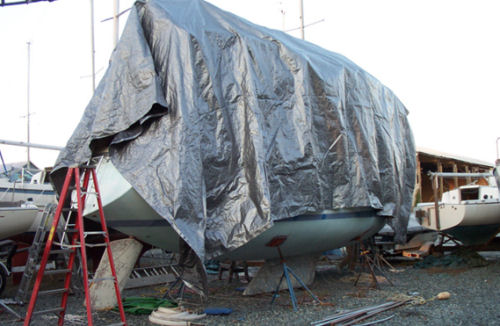
This blow-boater obviously only read the part about having a cover. Now he needs to know what to do with it. If you happen to know one of these tweedy souls, please flip them this article.
Winter Covers, Tarps, and Frames
By Paul Esterle, author of “Maintain and Improve Your Powerboat”
Why use covers or tarps along with frames instead of shrink-wrapping? There are several different reasons. If you plan on keeping the boat indoors, for example, an inexpensive generic cover would be fine. If you are planning on keeping the boat for several years, the cost of a custom cover and decent frame can be amortized over those years and actually cost less than shrink-wrapping.
You may be planning on working on the boat and need decent headroom and easy access to various parts of the deck. Finally, you may have an oddly configured boat that may make shrink-wrapping difficult and a precisely fitted cover more practical.
Covers
There is a pecking order in covers, ranging from the custom-made and fitted cover at the top to the generic off-the-shelf cover at the bottom. These covers are also made for different purposes; it is important to pick the right one for the right job.
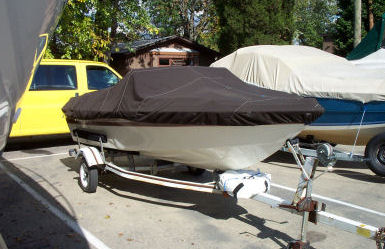
This is a good example of a custom-fitted cover that will protect the boat in the off season.
Manufacturers offer covers in a wide range of fabrics. A quick look at some websites offers the following material types:
100% Cotton
DuPont™ Tyvek®
100% polyester with acrylic coating
Olefin fabric with a waterproof coating
The purpose of your cover will determine the type of material needed. Top-of-the-line cover material is required for outdoor use in the winter. The material needs to be waterproof, to shed water obviously. It would also be nice if the surface texture was at least a little bit slippery to shed snow and ice. An average useful life of eight to ten years can be expected of a well-constructed custom cover built of the best fabric.
The less expensive materials are suitable for use when storing the boat under cover, such as in a garage or shed. Why do you need a cover when storing indoors? Think birds, or at least the surprises birds can leave behind. Better to leave those on the cover than inside your boat. A cover will also keep out other critters looking for a cozy home for the winter as well as keep the general dirt and dust out of the inside of the boat.
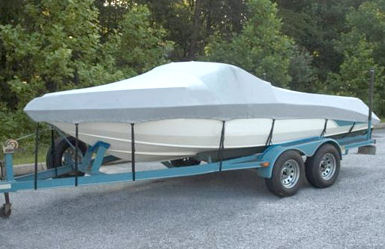
Another example of a powerboater taking pride in his boat and protecting it both going down the road and in winter.
Having decided where you’ll be storing your boat, you can consider the type of cover you’ll need. Again, custom covers are made for your exact model and type of boat. These covers are a little more expensive but can be cost-effective if used for many years. They fit tightly and have robust tie down or fastener systems to prevent flapping and the resultant scuffing of your gelcoat. [Scuffing of gelcoat by snaps and fasteners while going down the road or during winter storms is a common problem, so be on guard.—Ed.]
Cover Makers Abound
Check with an established cover maker or canvas provider as they may already have a pattern for your boat. I know one manufacturer, Fisher Canvas Products, Inc. of Burlington, NJ, has patterns dating back to the early 1960s. Their covers are also exceptionally long-lived, some lasting as long as 10 to 15 years with proper care and repair. [Several years ago BoatTEST.com used to retail covers and used Taylor Made as our vendor. They make custom and generic covers. Customers were happy and the prices were right.—Ed.]
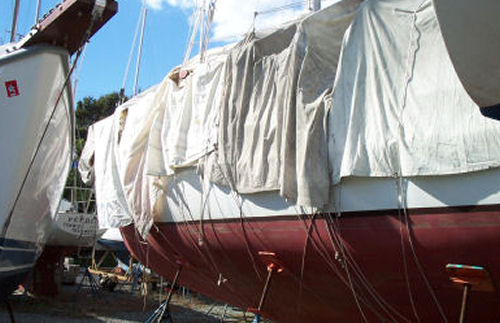
What is it about sailors? It looks like he bought his covers at Goodwill.
Generic Covers
At the bottom of the cover food chain are the stock or generic covers sold by many boat stores. These are available in several grades of material. Most stores will have some sort of catalog or configuration sheet available, listing the different covers for different configurations of boats, e.g., V-hull, cuddy cabin, bow riders. Each configuration has several different length and beam configurations available.
You pick the closest match to your boat and hope for the best. Most of these covers have a rope or elastic drawstring along the bottom edge. This helps snug down the cover on your boat but must be supplemented with additional straps or lines to tie the cover down. [We emphasize this point as wind can loosen the drawstring and eventually blow off the cover.—Ed.]
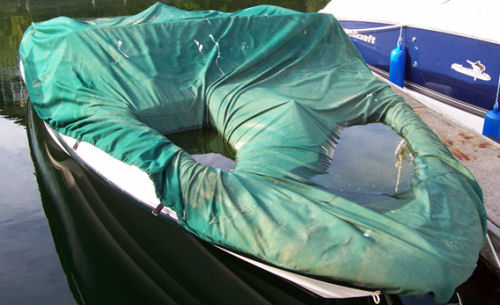
This boat cover makes a great place for birds to come for a drink of water and a splash bath.
Cover Support
Any style cover must be properly supported to prevent water from pooling. Some options are extendable cover poles or flexible battens. The extendable poles fit into grommets or sockets in the cover to hold it up. The battens fit into special fittings in either side of the boat and bow upwards to support the cover.
You can also use inflatable tow tubes (used for tubing and towed behind your boat) or similar products to support the cover. In some cases a framework may be necessary. I’ll discuss this at the end of the article. The important thing is to eliminate the sags and the flapping of the cover.
One additional thing to check for is an adequate number of vents, especially for the waterproof covers. Like a shrink-wrapped boat, ventilation is necessary to prevent condensation, mold, and mildew during the winter storage season.
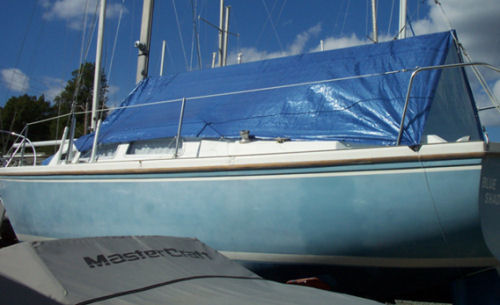
While this sailor has saved money on his tarp, he will be paying dearly in the spring for the ice damage. Note the care with which the MasterCraft owner in the foreground has taken of his prized vessel.
Tarps
For every boat with a neatly fitted cover, I probably see a dozen others using the old standby, a blue, silver, green, white or black tarp. These tarps come in a bewildering selection of sizes, colors, weights and prices. You used to be able to tell the quality of the tarp by the color. Blue being the lowest quality with silver or green being the best. Nowadays it is much harder as the color no longer signifies the quality. Probably the best gauge of quality now is the weight; the heavier the tarp, the better the material. They are much less expensive than any other type of cover.
Whatever quality tarp you buy, it will need to be longer than the boat, at each end, to be able to wrap it around the bow and stern and tuck it into place. All the tarps I’ve seen have regularly spaced grommets for tying the tarp down. You may well need to tie off at locations where there are no grommets. Most places selling tarps also have grommet or tarp tie-down fittings to add those extra tie-downs where needed.
Tarp Tie-Down Advice
Tarps are much harder to properly tie down and are much more subject to flapping in the wind than other types of covers. Spend the extra time and the extra line to get your tarp or tarps tied down properly. Don’t expect the tie downs to remain tight all winter. Get out and check them regularly. If you don’t, you risk the cover shredding prematurely off the loose lines scuffing your gelcoat.
By the way, NEVER TIE THE TARP OR COVER TO THE BOAT STANDS! The constant motion of the tarp and lines from the wind can actually work the boat stands loose, thereby ruining your whole boating experience, not to mention your neighbors. Be sure the boat stands are chained together, side-to-side, to keep them from walking out from under the boat.
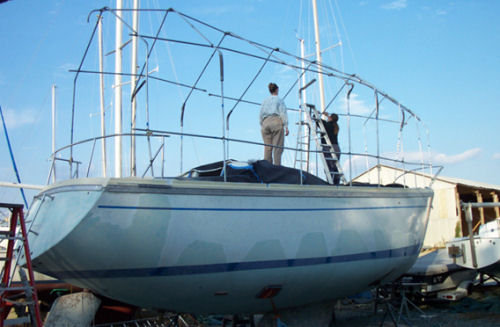
The photo shows a winter frame on a sailboat being built with Kover Klamps. The boat is being worked on during the winter so the frame allows standing headroom on deck. Obviously, Shaquille O’Neal and four of his chums will be doing the work.
Frames
There are many styles of frames built from many kinds of materials. The frames are used to support the cover or tarp. Frames are also to keep the cover from letting water pool and to allow access to the boat under the cover.
At one time, almost all frames were made of wood. Some of these frames were works of woodworking art, intricately shaped and assembled with precision. These frames were knocked down and stored each spring for use in the next fall haul-out. Other wood frames were cobbled together from furring strips and common lumber and were often discarded at the end of a season.
How to Get Framed
The boat owner now has several different choices for frame material and some unique frame parts available. White PVC tubing has been used for frames many times. Individual lengths of tubing are bent into arches and fastened to stanchions with hose clamps, duct tape or large wire ties.
Other lengths of tubing can be run fore and aft to act as rafters and ridgepole. Fasten these on the inside of the frame to make pulling the cover over the boat much easier. The individual PVC arches may need to be supported in the middle if you are expecting a heavy snow load.
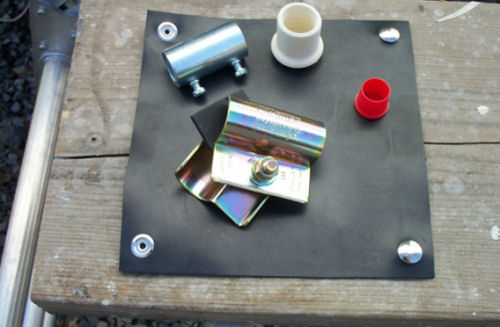
Kover Klamp system, from upper left: conduit connector, rubber foot, closure for tube ends, Kover Klamp, all on a rubber protector snap pad.
Cheap But Good Frames
Another option for frame material is electrical conduit or EMT. This tubing is available at any home improvement store, in 10-foot lengths and at a dirt-cheap price. It can be cut to length with a simple tubing cutter. Bending is also simple using an electrician’s conduit bender.
To make assembling a conduit frame much easier, there are specially designed clamp systems available. These clamps, called Kover Klamps, will hold two pieces of tubing together at any angle. The complete system includes protective rubber pads to snap around the Kover Klamps (To protect the tarp from any sharp edges), special connectors are available for connecting lengths of conduit together and rubber feet to prevent damage to the gelcoat on your deck. A video is available from Kover Klamps to take you through the entire process of erecting a conduit frame.
Kover Klamps
Cut the Corners!
One of the most important factors in a successful winter frame is the elimination of any sharp corners or rough spots on the frame or the boat. Any of these will ruin a cover or tarp in no time. Pad the sharp corners with carpet scraps well fastened in place. Split foam pipe insulation works well on conduit as long as it’s firmly taped in place.
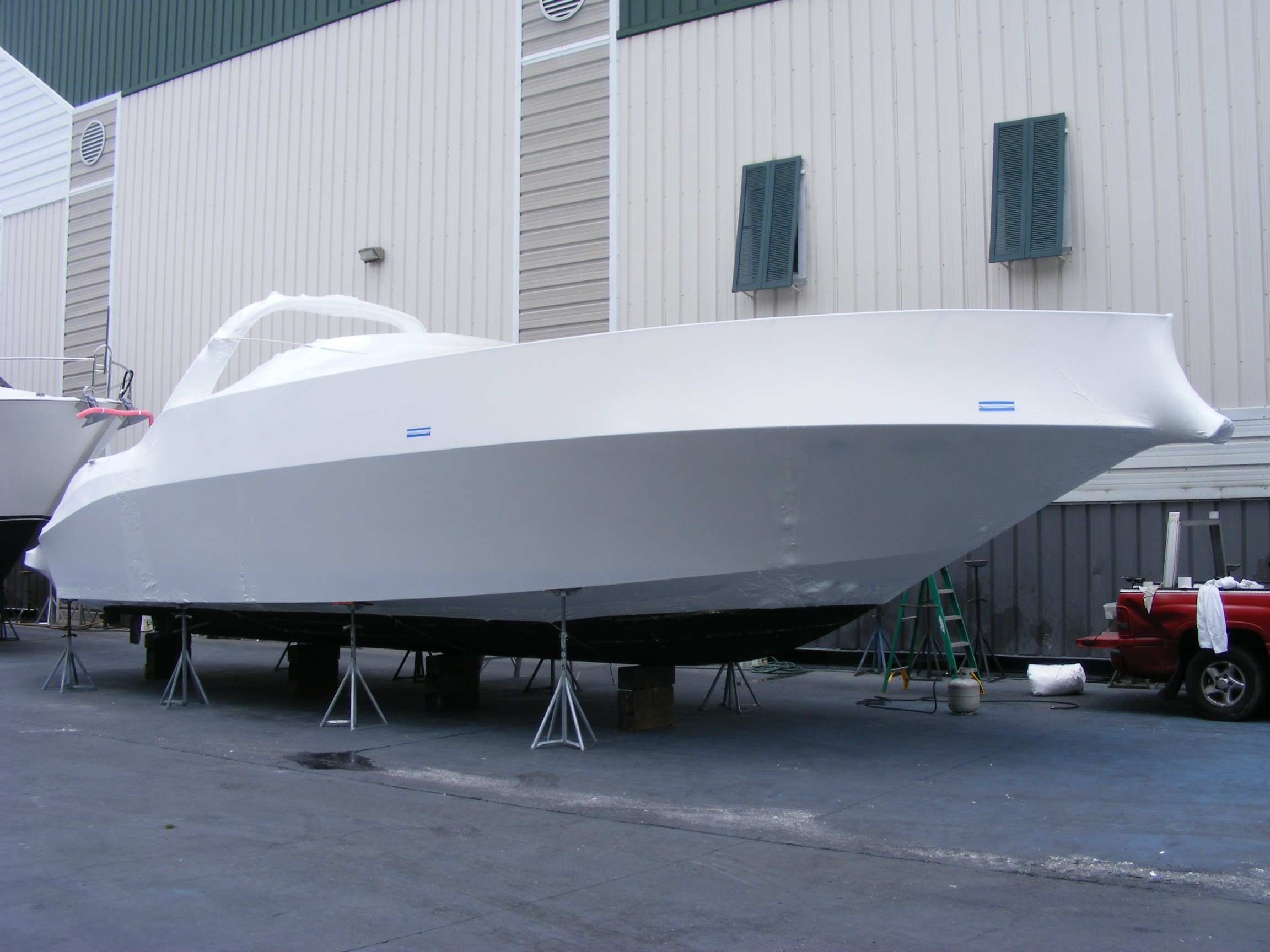
Why not forget about all of this work and expense and just pay the boatyard to winterize and shrink-wrap your boat and be done with it?
If you plan on reusing your frame next year, make sure you properly mark each piece with an identifying mark. Make an overall sketch or diagram for the frame so you know where each piece goes. Depend on your memory, and you’ll be standing among a bunch of parts wondering where they go.
Finally
Don’t just cover up your boat and wait until spring. Check it regularly for loose ropes, slipped frames or holes in the cover. Fix the problem before the cover or tarp is ruined and needs replacement. There is nothing like trying to horse a heavy cover or large tarp in place during a snowstorm with a negative-10-degree wind-chill factor.
---Article by Paul Esterle, author of Maintain and Improve Your Powerboat, which is published by McGraw-Hill.
Visit his website for how-to tips at www.thevirtualboatyard.com.